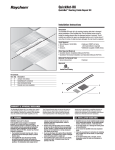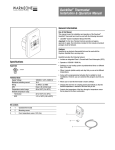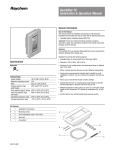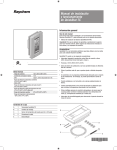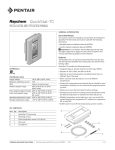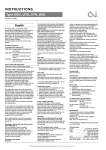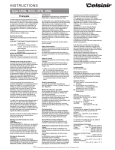Download Raychem QuickStat Installation manual
Transcript
QuickStat™ Thermostat Installation & Operation Manual General Information Use of this Manual This manual covers the installation and operation of the Raychem® QuickStat™ thermostat and must be used with the following document: • QuickNet™ System Installation Manual (H57704) Important: For the Tyco Thermal Controls warranty and agency approvals to apply, the instructions included in this manual and product packages must be followed. Features QuickStat is an electronic thermostat that must be used with the Raychem QuickNet floor warming mats. QuickStat provides the following features: • Includes an integrated Class A, Ground-fault Circuit Interrupter (GFCI). Specifications • Operates at 120/240 V 50/60 Hz. Approvals • Switches on your heating system at predetermined times on different days of the week. C US E157297 • Offers 4 periods (called events) each day that you can set at different temperatures. LISTED 2D03 • Comes with a preprogrammed schedule that is suitable for most installations. However, you can customize this program any time you wish. Technical Data Supply Voltage Maximum switching current Wiring GFCI Temperature control range Ambient temperature range Thermostat GFCI 120/240 V ±15%, 50/60 Hz 16 A 12 AWG to 22 AWG Class A (5 mA trip level) 40 to 104˚F (5 to 40°C) • Allows you to reset the thermostat to factory settings. • Changes the start time of a heating period automatically so that the desired temperature is reached at the time that you set. • Controls the temperature of the floor through a temperature sensor that is placed in the floor construction. 32 to 104˚F (0 to 40°C) –31 to 149˚F (–35 to 65°C) Kit contents A 1 QuickStat thermostat B 2 Mounting screws C 1 Floor temperature sensor 10 ft (3m) A B C 2 QuickStat Installation & Operation Manual Installation Important: This thermostat must be installed according to all national and local electrical codes. The installation must be performed by qualified personnel. Mounting the thermostat in the electrical box 1. Use a screwdriver to remove the cover. Locating the floor temperature sensor The floor temperature sensor is installed under the floor surface. See the QuickNet System Installation Manual (H57704), Section 6, for more details. If required, the sensor cable can be extended to about 300 ft (91 m). Wiring the thermostat WARNING: TURN OFF THE POWER TO THE CIRCUIT AT THE MAIN POWER PANEL TO AVOID ELECTRIC SHOCK. 1. Connect power to the thermostat’s line terminals marked “L1 (L)” and “L2 (N)”. 2. Connect the floor warming cold lead to the load terminals marked “Load 16A Max”. 2. Mount the thermostat in the wall socket and re-attached the cover. Thermostat Controls and Display Symbols The following figure shows the thermostat controls: QuickStat® GFCI Class A LINE Line (black) L1 (L) 240/(120)VAC Neutral (white) L2 (N) SENSOR LOAD 16A Max. Cold lead Reset button Cold lead Red light indicating ground-fault Adjustment up Reset OK - accept GFCI Test 1/4" (6 mm) Strip length R Test button Adjustment down Pin button for adjusting clock Reset button for factory settings Digital display 3. Connect the floor temperature sensor to the screw-less terminals marked “Sensor”. Push on the terminal spring with a screwdriver and insert the wires. The following figure shows the symbols that appear in the display window while you are programming: A C ) )V A (L L1 20 (N ) (1 0/ Hig UT po h VolION wer ta : su ge pp D ly is co be DU fore nnec 38 AL V se t 40 rvic 19 W OLT 20 /240 AG ing W/2 V E 12 AC 50/6 0V (1 0 AC 6A Hz (16A) ) E N S O R 1 M 6A ax . LO A D Night S 24 Wake L2 Q G uic F k s LI CI Sta N Cla t E s ® 4-event symbol: Clock function Out CA Manual mode Home % switch-on time Time and temperature Day number Heating on 3 QuickStat Installation & Operation Manual Initializing the Thermostat Testing GFCI Setting the thermostat into operation The first time you power up the thermostat, the time and day will flash and must be set. You will also need to select the time scale (12 h or 24 h) and temperature scale (°F or °C). If you need to adjust the time or day in the future, i.e. for for daylight savings time, simply insert a pin into the hole ( ) and make the necessary adjustments. Setting time and temperature scale can also be done in the Advanced Settings and ReadOut section on page 5. Press the UP ( ) or DOWN ( ) buttons to set the correct time and press the OK ( ) button. Actions To check the GFCI: 1. Testing can only be performed if the thermostat has a heating demand. 2. Adjust the set point until the heating symbol ( ) appears, use the ( ) button, to increase the temperature. Wait 10 seconds to let the thermostat adjust to the new set point. 3. Press the "TEST" button. Setting the current time Display You must test the GFCI to verify correct installation and function. Result The test is successful if the red light on the thermostat lights, and the display signs disappear. If this does not occur, check the installation. 1. Press the RESET button to reset the GFCI. The red light should disappear and the display will return to normal appearance. 2. Press the OK ( ) button to cancel the previously set temperature. 3. If the test fails, check your heating cable and the thermostat. Setting the current day Then press the UP ( ) or DOWN ( ) button to set the correct day of the week and press the OK ( ) button. Display Actions Result If the GFCI trips in normal operation without pressing the TEST button, there could be a ground fault. To check whether it is a ground fault or nuisance tripping, press RESET. If the red light turns off and does not come on again, it was nuisance tripping and the system is functioning properly. If the ground fault cannot be reset, there is a ground fault. Check your heating cable, the sensor cable and the thermostat. Replace if necessary. Care and maintenance You should perform the GFCI test monthly. Setting the temperature and time preferences Press the UP ( ) button to select 12 hour or 24 hour clock and to select Fahrenheit or Celsius and press the OK ( ) button. Display Actions Result Factory settings The following table shows the default settings that are programmed into the thermostat from the factory. You can accept the factory settings, or customize them to meet your needs. See Programming on page 4 to customize your settings. 4-event time and temperature Day 1 - 5 Time Temperature 6:00 a.m. 77°F / 25°C 8:00 a.m. 68°F / 20°C 4:00 p.m. 77°F / 25°C 10:00 p.m. 68°F / 20°C 6:00 a.m. 77°F / 25°C 11:00 p.m. 68°F / 20°C Day 6 - 7 Other settings 4-event sequence 5:2 Hi-Low temp. 104°F / 41°C Scale 12 H / °F Adaptive control ON OFF / OFF If you wish to reset the thermostat to factory settings, simply push the pin button marked “R” for 3 seconds and the thermostat returns to factory settings. Time, day and scale for time (12h, 24h) and temperature (˚F, ˚C) read-outs are also reset. 4 QuickStat Installation & Operation Manual Daily Use of the Thermostat Programming 4-event clock mode 4-event time and temperature Each day has been split into 4 events describing a typical day. When the thermostat is in 4-event mode it will automatically adjust according to the required temperature and required time. The factory preset program has 5 days with 4 events, and 2 days with 2 events. For more details, see Programming. The table below shows the default time and temperature settings, however, you can easily change each setting as needed. For example, in the morning you may want the floor to be warm at 7:00 a.m. and the temperature to be 80˚F, and so on for other events. Simply follow these steps: Press the OK ( ) button for 3 seconds and the start time displays. Press the UP ( ) or DOWN ( ) button until you reach your desired time. Press the OK ( ) button to confirm. Your selected time displays. Then, press the UP ( ) or DOWN ( ) button until you reach your desired temperature. Press the OK ( ) button to confirm. Your selected temperature displays. Repeat these two actions for the remaining events. These settings will be valid with days 1-5 showing on the display. To program the days 6 and 7, repeat the above. Days 6 and 7 are usually Saturday and Sunday, and only have two events. 4-event clock mode: The clock function symbol ( ) and one of the 4-event symbols ( ) will be indicated. For more details, see Programming. The temperature can be set within the range of 41°F to 104˚F. It is also possible to select the heating OFF at that event by reducing the setting to 41˚F, and then pressing the ( ) once more. Press OK ( ) button for 3 seconds to begin programming Day 1 - 5 Time Temperature Time Temperature Temporary override: Wake settings To temporarily override the temperature in the 4-event schedule program, press the UP ( ) or DOWN ( ) button once, to show the temperature, and press again to increase or decrease the temperature. The display will flash for 5 seconds, and will then revert to the time. The override will operate until the next programmed event when the unit will resume the automatic program. Out settings Home settings Cancel comfort mode: To cancel the override state, press the OK ( ) button twice. Night settings Permanent override: During holidays, the scheduled 4-event program can be overridden. Press the OK ( ) button, and then the UP ( ) or DOWN ( ) button until the override temperature is set. The unit will operate at this temperature until you change the temperature or cancel the permanent override state. Cancel manual mode: To cancel the permanent override state, press the OK ( ) button once, and the unit will resume automatic function. Turning thermostat off: To turn the thermostat OFF, press the DOWN ( ) button until you reach 41˚F, press the OK ( ) button, then press the ( ) once more. DO NOT USE THE TEST BUTTON ON THE GFCI TO SWITCH OFF THE HEATING SYSTEM. The GFCI automatically resets after a power outage. Day 6 - 7 Wake settings Night settings 5 QuickStat Installation & Operation Manual Advanced Settings and Read-Out Press both the UP ( ) and DOWN ( ) buttons together for 3 seconds. "INFO" is displayed. Press the UP ( ) button until you reach the desired sub menu. Select the sub menu with the OK ( ) button. Maximum and minimum allowed temperature range The temperature setting range of 41˚F to 104˚F can be limited to prevent a too high or too low temperature from being selected. Set the maximum allowed temperature. Use the UP ( ) or DOWN ( ) button to increase or reduce and the OK ( ) button to accept. Monitoring energy consumption The thermostat calculates the average time it has been switched on allowing you to monitor your energy consumption. The thermostat displays the total switch-on time as a percentage for the last 2 days, 30 days or 365 days. Next "LoLi" is displayed. Press the OK ( ) button to continue. Calculation of operational costs per day: (switch-on time:100) x kW x kWh-price x 24 h per day Example: Read-out: 30% in the latest 365 days Size of heating system: 1.2 kW (ask the installer) Cost of power: 0.2 USD/ kWh - Calculation: (30:100) x 1.2 kW x 0.2 USD/ kWh x 24 h = 1.7 USD per day Set the minimum temperature that the floor should never fall below. Use the UP ( ) or DOWN ( ) button to increase or reduce and the OK ( ) button to accept. Note: It is possible to select the heating OFF as your "LoLi" setting by reducing the setting to 41˚F, and then pressing the ( ) once more. 2 days 30 days 365 days Software version Temperature sensor Time and temperature scale selection You can select either ˚F˚ or C scale, and 12 or 24 hour clock as follows: Press the UP ( ) or DOWN ( ) button to show the different readouts. Press the UP ( ) or DOWN ( ) button to change settings. Confirm the required scale with the OK ( ) button. No changes can be made here. Use the OK ( ) button to end. 4-event sequence The present event sequence flashes: Days 1-5, followed by days 6-7. To change, press the UP ( ) button until you have days 1-6 and then day 7 flashing, or all 7 days are flashing. Select the required sequence with the OK ( ) button. 5-2: 4 events in 5 days + 2 events in 2 days. 6-1: 4 events in 6 days + 2 events in 1 day 7-0: 4 events in 7 days Adaptive function This function enables the thermostat to calculate when it needs to switch ON so that the required temperature is reached at the set time. With a start time of 7:00 a.m. therefore, the thermostat may switch ON as early as 6:00 a.m. so that the desired temperature of 77˚F is achieved by 7:00 a.m. Without this function set, the thermostat will start to heat at the time you set. Press the DOWN ( ) button to switch between on and off. Press the OK ( ) button to confirm. Ending the programming sequence Press the OK ( ) button to end programming and to return to scheduled program. 6 QuickStat Installation & Operation Manual Sensor Testing If the sensor is disconnected or short-circuited, the heating system is turned off. Test your sensor according to the following resistance table: Sensor Temp (˚C) Temp (˚F) Value (ohm) –10 –14 64000 0 32 38000 10 50 23300 20 68 14800 30 86 9700 Error Codes Tyco, Raychem, QuickNet and QuickStat are trademarks of Tyco Thermal Controls LLC or its affiliates. Worldwide Headquarters Tyco Thermal Controls Canada Tyco Thermal Controls 300 Constitution Drive Menlo Park, CA 94025-1164 USA Tel (800) 545-6258 Fax (800) 596-5004 [email protected] www.tycothermal.com 250 West St. Trenton, Ontario Canada K8V 5S2 Tel (800) 545-6258 Fax (800) 596-5004 Important: All information, including illustrations, is believed to be reliable. Users, however, should independently evaluate the suitability of each product for their particular application. Tyco Thermal Controls makes no warranties as to the accuracy or completeness of the information, and disclaims any liability regarding its use. Tyco Thermal Controls' only obligations are those in the Tyco Thermal Controls Standard Terms and Conditions of Sale for this product, and in no case will Tyco Thermal Controls or its distributors be liable for any incidental, indirect, or consequential damages arising from the sale, resale, use, or misuse of the product. Specifications are subject to change without notice. In addition, Tyco Thermal Controls reserves the right to make changes—without notification to Buyer—to processing or materials that do not affect compliance with any applicable specification. © 2005 Tyco Thermal Controls LLC H57725 12/05 E0: Internal error. The thermostat must be replaced. E2: External sensor short-circuited or disconnected. Instructions d’installation et d’opération du thermostat QuickStat™ Information générale Utilisation de ce manuel Ce manuel couvre l’installation et l’utilisation du thermostat Raychem® QuickStat™, et doit être utilisé avec le document suivant : • Manuel d’installation du système QuickNet™ (H57704) Important : La garantie de Tyco Thermal Controls et les homologations ne sont valides que si les instructions de l'emballage et du présent manuel sont respectées. Caractéristiques QuickStat est un thermostat électronique qui doit être utilisé avec les tapis chauffants Raychem QuickNet. Caractéristiques du thermostat QuickStat : • Disjoncteur différentiel de classe A intégré. Spécifications • Fonctionne sous 120/240 V 50/60 Hz. Approbations • Alimente votre système chauffant à des heures prédéterminées pour les différents jours de la semaine. C US E157297 LISTED 2D03 • 4 périodes (ou événements) par jour pour le réglage de températures différentes. • Programme standard convenant pour la plupart des installations. Caractéristiques techniques Tension d’alimentation Capacité de commutation Câblage Disjoncteur différentiel 120/240 V ±15%, 50/60 Hz 16 A Fils 12 AWG à 22 AWG Classe A (niveau de déclenchement :5 mA) Gamme de réglage de la température 5 à 40 °C (40 à 104 ˚F) Gamme de température ambiante Thermostat 0 à 40 °C (32 à 104 ˚F) Disjoncteur –35 à 65 °C (–31 à 149 ˚F) • Ce programme peut être personnalisé à volonté. • Réinitialisation pour retrouver les réglages d’usine du thermostat. • Préchauffage automatique pour que la température désirée soit atteinte à l’heure programmée. • Règle la température du sol au moyen d’une sonde incorporée dans la construction du plancher. Contenu de kit A 1 thermostat QuickStat B 2 vis de fixation C 1 sonde de température de plancher avec fil de 3 m (10 pi) A B C 8 Instructions d’opération et d’utilisation du thermostat QuickStat Montage du thermostat dans la boîte électrique Installation 1. À l’aide d’un tournevis, retirer le couvercle. Important: L’installation de ce thermostat doit être conforme aux codes de l’électricité national et local. Elle doit être faite par un technicien qualifié. Position de la sonde de température La sonde de température doit être installée sous la surface du plancher. Voir le manuel d’installation du système QuickNet (H57704), chapitre 6, pour plus de détails. Si nécessaire, la longueur du câble de la sonde peut être prolongée jusqu’à 91 m (300 pi). Câblage du thermostat ATTENTION : POUR ÉVITER LES CHOCS ÉLECTRIQUES, ISOLER LE CIRCUIT D’ALIMENTATION AU NIVEAU DU TABLEAU DE DISTRIBUTION ÉLECTRIQUE. 1. Brancher les fils de l’alimentation secteur du thermostat aux bornes marquées « L1 (L) » et « L2 (N) ». 2. Connecter le fil froid du système de chauffage aux bornes marquées « Load 16A Max ». 2. Monter le thermostat dans la prise murale et replacer le couvercle. Commandes du thermostat et symboles affichés La figure ci-dessous indique les commandes du thermostat : QuickStat® GFCI Class A LINE Phase (noir) L1 (L) 240/(120)VAC Fil froid Voyant rouge signalant un courtcircuit à la terre Fil froid Bouton de test. Neutre (blanc) L2 (N) SENSOR LOAD Bouton PLUS Bouton de réarmement Reset Bouton OK - Accepter GFCI Test R 16A Max. 6 mm (1/4 po) Dénuder Bouton MOINS Mini-bouton de réglage de l'horloge Mini-bouton de réinitialisation Afficheur La figure ci-dessous illustre les symboles qui apparaissent sur l’afficheur pendant la programmation : 3. Brancher la sonde de température du plancher aux bornes sans vis marquées « Sensor ». Appuyer sur le ressort de la borne avec un tournevis et engager les fils dénudés. Symboles 4 événements: Fonction horloge Réveil Nuit Départ C ) )V A (L ® Retour à la maison 20 L1 L2 (N ) (1 0/ Hig UT po h VolION wer ta : su ge pp D ly is co be DU fore nnec 38 AL V se t 40 rvic 19 W OLT 20 /240 AG ing W/2 V E 12 AC 50/6 0V (1 0 AC 6A Hz (16A) ) 1 M 6A ax . LO A D E N S O R % chauffage S 24 Q G uic F k s LI CI Sta N Cla t E s A Mode manuel Heure et température Jour de la semaine Chauffage actif CA 9 Instructions d’installation et d’opération du thermostat QuickStat Initialisation du thermostat Avant la mise en service du thermostat Lorsque vous branchez le thermostat, l’heure et le jour clignotent pour vous rappeler qu’ils doivent être programmés. Après avoir réglé l’heure et le jour, vous pouvez choisir entre l’horloge 12 heures ou 24 heures et l’échelle de température (°F or °C). Si vous devez régler l’heure ou le jour dans le futur, par exemple pour le passage à l’heure d’été, il suffit d’introduire une épingle dans le petit trou ( ) et de faire les réglages nécessaires. Le mode d’application de l’heure et l’échelle de température peuvent également être changés dans la section Réglages avancés et Affichage, page 5. Setting the current time Appuyez sur le bouton PLUS ( ) ou MOINS ( ) jusqu’à obtenir l’heure désirée, appuyez sur le bouton OK ( ). Affichage Actions Résultat Si le test est normal, le voyant rouge GFCI s’allume et l’affichage du thermostat disparaît. Si ce n’est pas le cas, vérifiez l’installation. 1. Appuyez sur le bouton RESET de réarmement du disjoncteur. Le voyant rouge doit s’éteindre et l’affichage, réapparaître. 2. Appuyez sur le bouton OK ( ) pour annuler le changement de température de consigne. 3. Si le résultat du test n’est pas normal, vérifiez le câble de chauffage et le thermostat. Si le disjoncteur différentiel se déclenche en fonctionnement normal (sans que vous ayez appuyé sur le bouton TEST), il peut s’agir d’un court-circuit à la terre. Pour déterminer s’il s’agit d’un défaut ou d’une fausse alarme, appuyez sur le bouton de réarmement (RESET). Si le voyant rouge s’éteint et ne se rallume pas, c’était une fausse alarme et votre système fonctionne normalement. Si le disjoncteur ne peut pas être réarmé, il y a probablement un court-circuit à la terre. Vérifiez le câble de chauffage, le câble de la sonde et le thermostat. Remplacez tout élément défectueux. Jour de la semaine À l’aide des boutons PLUS ( ) et MOINS ( ) choisissez le jour de la semaine actuel et appuyez sur le bouton OK ( ). Affichage Actions Résultat Essais et entretien Le disjoncteur différentiel devrait être testé une fois par mois. Réglages d’origine Le tableau ci-après indique les réglages par défaut qui ont été programmés en usine pour le thermostat. Si ces réglages ne vous conviennent pas, vous pouvez les changer à volonté. Voir « Programmation », page 4 pour personnaliser votre thermostat. Réglage des préférences de température et d’heure Séquence 4 événements Heure et Température Appuyez sur le bouton PLUS ( ) pour sélectionner l’horloge 12 heures (AM/PM) ou l’horloge 24 heures, de même pour l’échelle Fahrenheit ou Celsius, et appuyez sur le bouton OK ( ). Jours 1 - 5 Affichage Actions Résultat Heure Température 6:00 a.m. 77°F / 25°C 8:00 a.m. 68°F / 20°C 4:00 p.m. 77°F / 25°C 10:00 p.m. 68°F / 20°C 6:00 a.m. 77°F / 25°C 11:00 p.m. 68°F / 20°C Jours 6 - 7 Autres réglages Test du disjoncteur différentiel Séquence 4 événements 5:2 Le test du disjoncteur permet de vérifier que l’installation est correcte et que le système fonctionne normalement. Temp. maxi/mini 104°F / 41°C Échelle 12 H / °F Mode adaptatif ON Pour tester le disjoncteur différentiel : 1. Le test ne peut se faire que si le thermostat détecte une demande de chauffage. 2. Réglez le point de consigne jusqu’à ce que le symbole de chauffage ( ) apparaisse; appuyez sur le bouton ( ) pour augmenter la température. Attendez 10 secondes que le thermostat s’ajuste au nouveau point de consigne. 3. Appuyez sur le bouton « TEST ». OFF / OFF Pour réinitialiser le thermostat à sa configuration d’origine, enfoncez une pointe dans le petit bouton marqué « R » et maintenez-le pendant 3 secondes. Le thermostat revient à ses réglages d’origine. L’heure, le jour et le type d’heure (12 heures, 24 heures), ainsi que l’échelle de température (˚F, ˚C) sont également réinitialisés. 10 Instructions d’opération et d’utilisation du thermostat QuickStat Utilisation quotidienne du thermostat Programmation Mode horloge 4 événements Heures et températures 4 événements Chaque jour est divisé en 4 événements préréglés. Si le thermostat est en mode 4 événements, il commande automatiquement la température requise au moment programmé. Le programme d’origine, réglé en usine, comporte 5 jours à 4 événements et 2 jours à 2 événements. Pour plus de détails, voir « Programmation ». Le tableau ci-après illustre les réglages par défaut des heures et des températures. Vous pouvez cependant les changer à volonté. Par exemple, le matin vous pouvez vouloir que le plancher soit chaud à 7 heures a.m. et que la température soit de 80 ˚F, et ainsi de suite pour les autres événements. Pour programmer le thermostat : Appuyez sur le bouton OK ( ) pendant 3 secondes pour faire apparaître l’heure de début. Utilisez les boutons PLUS ( ) et MOINS ( ) pour fixer l’heure désirée. Appuyez sur le bouton OK ( ) pour confirmer. L’heure sélectionnée est affichée. Appuyez ensuite sur le bouton PLUS ( ) ou le bouton MOINS ( ) pour fixer la température désirée. Appuyez sur le bouton OK ( ) pour confirmer. La température sélectionnée est affichée. Répétez ces deux séquences d’opérations pour les autres événements. Mode 4 événements : Le symbole de la fonction horloge ( ) et l’un des 4 symboles d’événement ( ) s’affichent. Pour plus de détails, voir « Programmation ». Mode confort temporaire : Pour changer manuellement la température du programme à 4 événements, appuyez sur le bouton PLUS ( ) ou le bouton MOINS ( ) une fois pour faire apparaître la température et utilisez le bouton approprié pour augmenter ou diminuer sa valeur. L’affichage clignote pendant 5 secondes et l’heure réapparaît. Le changement n'est valide que jusqu’au prochain événement programmé, après quoi le thermostat revient à son programme automatique. Annulation du mode confort : Pour annuler le mode confort, appuyez deux fois sur le bouton OK ( ). Mode manuel permanent : Pendant les vacances, le programme normal à 4 événements peut être désactivé. Appuyez sur le bouton OK ( ) puis sur le bouton PLUS ( ) ou le bouton MOINS ( ) pour fixer la température désirée. Le thermostat fonctionnera à cette température jusqu’à ce que vous la changiez ou que vous annuliez le mode permanent. Annulation du mode manuel permanent : Pour annuler le mode manuel permanent, appuyez une fois sur le bouton OK ( ) : le thermostat reprend son fonctionnement automatique. Arrêt complet du chauffage : Pour arrêter le chauffage, appuyez sur le bouton MOINS ( ) jusqu’à ce que la température atteigne 41 ˚F, puis appuyez sur le bouton OK ( ) et à nouveau sur ( ). N’UTILISEZ PAS LE BOUTON TEST DU DISJONCTEUR DIFFÉRENTIEL POUR COUPER LE CHAUFFAGE. Le disjoncteur différentiel se réarme automatiquement après une panne de courant. Ces réglages seront appliqués aux jours 1-5 indiqués sur l’affichage. Pour programmer les jours 6 et 7, répétez les opérations ci-dessus. Les jours 6 et 7 correspondent normalement au samedi et au dimanche et ne comportent que deux événements. La température peut être réglée entre 41 °F et 104 ˚F. Il est également possible d'arrêter le chauffage d’un événement en réduisant la température à 41 ˚F et en appuyant à nouveau sur le bouton ( ). 11 Instructions d’installation et d’opération du thermostat QuickStat Réglages et affichages avancés Appuyez sur les deux boutons PLUS ( ) et MOINS ( ) pendant 3 secondes : l’afficheur indique « INFO ». Appuyez sur le bouton PLUS ( ) jusqu’à l’affichage du sous-menu désiré. Appuyez sur le bouton OK ( ) pour sélectionner le sous-menu affiché. Réglage de la gamme de températures maximum-minimum La gamme de températures totale, de 41 ˚F à 104 ˚F, peut être limitée pour éviter que quelqu’un sélectionne une température trop haute ou trop basse. Pour régler la température maximum permise, appuyez sur les boutons PLUS ( ) ou MOINS ( ) pour augmenter ou réduire la température, puis appuyez sur le bouton OK ( ) pour confirmer. Surveillance de votre consommation d’énergie Le thermostat calcule la durée moyenne de chauffage pour vous permettre de calculer votre consommation d’énergie. La valeur affichée est le pourcentage du temps total de chauffage au cours des deux derniers jours, des 30 derniers jours ou des 365 derniers jours. Calcul des frais de chauffage par jour : (% chauffage/100) x kW x prix kWh x 24 h par jour L’afficheur indique « LoLi ». Appuyez sur le bouton OK ( ) pour continuer. Exemple: Affichage : 30 % au cours des 365 jours écoulés Puissance de chauffage : 1,2 kW (demandez à votre installateur) Coût de l'électricité: 0,10 $Can/ kWh - Calcul : (30/100) x 1,2 kW x 0,10 $Can/ kWh x 24 h = 0,86 $ par jour Vous pouvez maintenant sélectionner la température minimale au-dessus de laquelle le plancher ne descendra jamais. Utilisez les boutons PLUS ( ) et MOINS ( ) pour augmenter ou réduire, et le bouton OK ( ) pour accepter. Remarque : Pour couper complètement le chauffage, sélectionnez pour « LoLi » une valeur de température de 41 ˚F, appuyez sur OK pour confirmer et appuyez encore une fois sur( ). 2 days 30 days 365 days Software version Temperature sensor Choisir l'horloge et l'échelle de température Appuyez sur le bouton PLUS ( ) ou MOINS ( ) pour voir les différents affichages. Pour choisir l’indication en ˚F ou en ˚C, et l’horloge 12 heures ou 24 heures, procédez comme suit : Vous ne pouvez faire aucun changement dans ce mode. Appuyez sur le bouton OK ( ) pour quitter le mode. Appuyez sur le bouton PLUS ( ) ou MOINS ( ) pour changer d'option. Acceptez la valeur affichée en appuyant sur le bouton OK ( ). Séquence à 4 événements La séquence actuelle est affichée par le clignotement des jours : 1-5, suivis de 6-7. Pour changer la séquence, appuyez sur le bouton PLUS ( ) jusqu’à ce que les jours 1-6 clignotent, puis les 7 ensemble. Pour choisir la séquence qui vous convient, appuyez sur le bouton OK ( ). Mode adaptatif 5-2: 4 événements sur 5 jours + 2 événements sur 2 jours. 6-1: 4 événements sur 6 jours + 2 événements sur 1 jour 7-0: 4 événements sur 7 jours Ce mode permet au thermostat de calculer lui-même la durée du préchauffage pour la température désirée. Si vous avez fixé une heure de début de 7:00 a.m., le thermostat allumera (par exemple) le chauffage à 6:00 a.m. pour que la température de 77 ˚F soit atteinte à 7:00 a.m. Si ce mode n’est pas activé, le thermostat commencera à chauffer à l'heure que vous avez programmée. Appuyez sur le bouton MOINS ( ) pour alterner entre ON (activé) et OFF (désactivé). Appuyez sur le bouton OK ( ) pour continuer. Fin de la séquence de programmation Appuyez sur le bouton OK ( ) pour sortir du mode programmation et revenir au fonctionnement programmé normal. 12 Instructions d’installation et d’opération du thermostat QuickStat Vérification de la sonde de température Si la sonde est déconnectée ou en court-circuit, le système de chauffage ne fonctionnera pas. L’état de la sonde peut être vérifié en mesurant sa résistance conformément au tableau ci-dessous. Sonde Temp (˚C) Temp (˚F) Valeur (ohm) –10 –14 64000 0 32 38000 10 50 23300 20 68 14800 30 86 9700 Codes d’erreur Tyco, Raychem, QuickNet and QuickStat sont des marques de commerce de Tyco Thermal Controls LLC ou de ses sociétés affiliées. Worldwide Headquarters Tyco Thermal Controls 300 Constitution Drive Menlo Park, CA 94025-1164 USA Tel (800) 545-6258 Fax (800) 596-5004 [email protected] www.tycothermal.com Canada Tyco Thermal Controls 250 West St. Trenton, Ontario Canada K8V 5S2 Tel (800) 545-6258 Fax (800) 596-5004 Avertissement important: Toute l’information donnée ici, y compris les illustrations, est, à notre connaissance, exacte. Il incombe cependant à l’utilisateur de s’assurer indépendamment que chaque produit convient à l’application envisagée. Tyco Thermal Controls ne peut affirmer que ces renseignements sont exacts et complets et, en conséquence, décline toute responsabilité quant à leur utilisation. Les seules obligations acceptées par Tyco Thermal Controls sont celles qui figurent explicitement dans les conditions générales de vente du produit en question, à l’exclusion de toute responsabilité de Tyco Thermal Controls ou de ses distributeurs à l’égard de dommages incidents, indirects ou consécutifs découlant de la vente, de la revente ou de l’utilisation normale ou abusive du produit. Les spécifications techniques peuvent être modifiées sans préavis. De plus, Tyco Thermal Controls se réserve le droit de changer ses procédés de fabrication et les matériaux entrant dans la composition du produit sans en aviser l’acheteur, dans la mesure où cela n’affecte pas la conformité à l’une quelconque des spécifications applicables. © 2005 Tyco Thermal Controls LLC H57725 12/05 E0 : Erreur interne. Le thermostat doit être remplacé. E2 : Sonde externe en court-circuit ou déconnecté.












